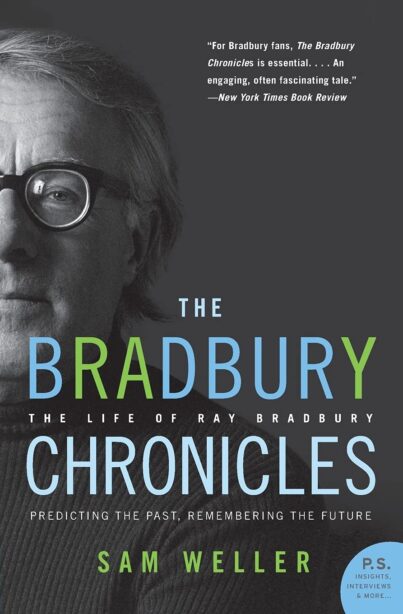 By SAM WELLER (William Morrow; 2005/12)
By SAM WELLER (William Morrow; 2005/12)
The first major biography of the late Ray Bradbury (1920-2012) and, I’m pleased to report, a good one. Author Same Weller is an admitted Bradbury superfan, and his book strikes the right balance between admiration and objectivity, and includes many Bradbury tidbits that aren’t publicly known. I, a longtime Bradbury admirer, was unaware (and a little shocked to learn) that this famously upstanding and inspirational child-man had a drinking problem, screwed around on his wife of 56 years and once told John Huston to fuck himself.
The book has problems, which stem from the fact that its contents were constructed largely from Bradbury’s own recollections, which I’m not sure were entirely reliable. He was, let’s not forget, a fanciful storyteller by trade, and that fancy extended to his supposedly nonfictional recountings. He’s told several versions of why he skipped college, claiming here that “I’m going to meet girls…That’s it. It’s the only reason I wanted to go to college—and that’s not a good enough reason” (as opposed to the more common claim that his family couldn’t pay the tuition). There’s also Weller’s description of Bradbury’s rationale for never learning to drive: because of a horrific car accident he witnessed as a teenager, the details of which have over the years been quite divergent. Then there’s Bradbury’s oft-repeated assertion that he remembers being born, which Weller treats with appropriate skepticism.
Bradbury’s depression-era childhood occurred in Waukegan, Illinois, and inspired a large portion of his fictional output. Those early years were lived in poverty (although the perpetually optimistic Bradbury claims not to have noticed) and dominated by Bradbury’s beloved Aunt Neva, a lesbian who stoked his imagination. At age thirteen Bradbury moved with his family to Los Angeles, CA, where, barring a half-year spent in Ireland for the filming of the Bradbury scripted MOBY DICK, he spent the remainder of his days.
Bradbury achieved fame as a writer in the late 1940s, and that fame only blossomed as he got older and turned out enduring classics like THE ILLUSTRATED MAN, THE MARTIAN CHRONICLES, FAHRENHEIT 451 and SOMETHING WICKED THIS WAY COMES. He became America’s de facto spokesperson for the Space Race of the late 20th Century (an odd state of affairs given that one of the main criticisms leveled at his so-called science fiction, as described here, is that it’s extremely light on science), in addition to a most unlikely TV personality in the late 1980s cable sensation THE RAY BRADBURY THEATER.
As his fame grew, however, the quality of Bradbury’s writing decreased. There’s a reason post-1980 Bradbury publications like DEATH IS A LONELY BUSINESS, FROM THE DUST RETURNED and QUICKER THAN THE EYE haven’t attained the esteem of the earlier books—and why Weller, after devoting a great deal of ink to those earlier books, rushes through the final chapters, which dispense very quickly with Bradbury’s later output.
Of this book’s two editions, the 2012 ebook version has the edge due to the fact that it takes into account its subject’s June 5, 2012 demise. The print version, published in 2005, obviously lacked that detail, although its pictorial section, reproducing intimate photos from Bradbury’s personal files, is far more extensive than that of the ebook.
